The Effect of Mineral Wool Fiber Additive on Several Mechanical Properties and Thermal Conductivity in Geopolymer Binder
Abstract
:1. Introduction
2. Materials and Methods
2.1. Materials
2.1.1. Mineral Stone and Glass Wool
2.1.2. Mineral-Wool-Based Geopolymers and Production Methodology
2.2. Research Methods
2.2.1. Mechanical Properties
2.2.2. Thermal Conductivity
3. Results
3.1. Compressive and Flexural Strength Test Results
3.2. Thermal Conductivity
4. Discussion
5. Conclusions
Author Contributions
Funding
Institutional Review Board Statement
Informed Consent Statement
Data Availability Statement
Conflicts of Interest
References
- Väntsi, O.; Kärki, T. Mineral wool waste in Europe: A review of mineral wool waste quantity, quality, and current recycling methods. J. Mater. Cycles Waste Manag. 2014, 16, 62–72. [Google Scholar] [CrossRef]
- Łaźniewska-Piekarczyk, B.; Smyczek, D.; Czop, M. Comparison of the Effectiveness of Reducing the Leaching of Formaldehyde from Immobilized Wool in Geopolymer and Cement Mortar. Appl. Sci. 2023, 13, 4895. [Google Scholar] [CrossRef]
- Ablaoui, E.M.; Malendowski, M.; Szymkuć, W.; Pozorski, Z. Determination of Thermal Properties of Mineral Wool Required for the Safety Analysis of Sandwich Panels Subjected to Fire Loads. Materials 2023, 16, 5852. [Google Scholar] [CrossRef] [PubMed]
- Smyczek, D. Problem zagospodarowania odpadów z wełny mineralnej—Idea gospodarki cyrkularnej; Współczesne Problemy Ochrony Środowiska i Energetyki 2021, pp. 360–367. Available online: https://repolis.bg.polsl.pl/dlibra/publication/83585#description (accessed on 10 January 2024).
- Łaźniewska-Piekarczyk, B.; Czop, M.; Smyczek, D. The Comparison of the Environmental Impact of Waste Mineral Wool and Mineral in Wool-Based Geopolymer. Materials 2022, 15, 2050. [Google Scholar] [CrossRef] [PubMed]
- Sattler, T.; Pomberger, R.; Schimek, J.; Vollprecht, D. Mineral wool waste in Austria, associated health aspects and recycling options 2020. Detritus 2020, 9, 174–180. [Google Scholar] [CrossRef]
- Yap, Z.S.; Khalid, N.H.A.; Haron, Z.; Mohamed, A.; Tahir, M.M.; Hasyim, S.; Saggaff, A. Waste Mineral Wool and Its Opportunities—A Review. Materials 2021, 14, 5777. [Google Scholar] [CrossRef]
- Ji, R.; Zheng, Y.; Zou, Z.; Chen, Z.; Wei, S.; Jin, X.; Zhang, M. Utilization of mineral wool waste and waste glass for synthesis of foam glass at low temperature. Construct. Build. Mater. 2019, 215, 623–632. [Google Scholar] [CrossRef]
- Sormunen, P.; Kärki, T. Recycled construction and demolition waste as a possible source of materials for composite manufacturing. J. Build. Eng. 2019, 24, 100742. [Google Scholar] [CrossRef]
- Trejbal, J.; Zobal, O.; Domonkos, M.; Prošek, Z. New possibilities for recycling of mineral wool separated from thermal insulation waste. Acta Polytech. CTU Proc. 2022, 34, 122–126. [Google Scholar] [CrossRef]
- Regulation of the Minister of Climate of 2 January 2020 on the waste catalogue (Journal of Laws of 2020, item 10). Available online: https://isap.sejm.gov.pl/isap.nsf/DocDetails.xsp?id=WDU20200000010 (accessed on 10 January 2024).
- Pranckevičienė, J. Impact of Mineral Wool Production Waste on Properties of Sintered Ceramics: Summary of Doctoral Dissertation. Ph.D. Thesis, Vilnius Gediminas Technical University, Vilnius, Lithuania, 2011; p. 24. [Google Scholar]
- Kubiliute, R.; Kaminskas, R.; Kazlauskaite, A. Mineral wool production waste as an additive for Portland cement. Cem. Concr. Compos. 2018, 88, 130–138. [Google Scholar] [CrossRef]
- Cheng, A.; Lin, W.-T.; Huang, R. Application of rock wool waste in cement-based composites. Mater. Des. 2011, 32, 636–642. [Google Scholar] [CrossRef]
- Väntsi, O.; Kärki, T. Utilization of recycled mineral wool as filler in wood–polypropylene composites. Constr. Build. Mater. 2014, 55, 220–226. [Google Scholar] [CrossRef]
- Zhuravlev, S.; Matyukhin, V.I.; Gol’tsev, V.A. Investigation of Fuel Briquettes Properties Using Wastes of Mineral Wool Production. Solid State Phenom. 2018, 284, 743–748. [Google Scholar] [CrossRef]
- Yliniemi, J. Mineral wool waste-based geopolymers. IOP Conf. Ser. Earth Environ. Sci. 2019, 297, 012006. [Google Scholar] [CrossRef]
- Davidovits, J. Why the Pharaohs Built the Pyramids with Fake Stones; Godefroy, J.C., Ed.; Institut Géopolymère: Paris, France, 2002. [Google Scholar]
- Davidovits, J. Soft mineralurgy and geopolymers. In Proceedings of the Geopolymer 88 International Conference, Compiegne, France, 1–3 June 1988. [Google Scholar]
- Błaszczyński, T.Z.; Król, M.R. Geopolymers in Construction/Zastosowanie Geopolimerów W Budownictwie. Civ. Environ. Eng. Rep. 2015, 16, 25–40. [Google Scholar] [CrossRef]
- Duxson, P.; Mallicoat, S.W.; Lukey, G.C.; Kriven, W.M.; van Deventer, J.S.J. The effect of alkali and Si/Al ratio on the development of mechanical properties of metakaolin-based geopolymers. Colloids Surf. Physicochem. Eng. Asp. 2007, 292, 8–20. [Google Scholar] [CrossRef]
- Okoye, F.N.; Durgaprasad, J.; Singh, N.B. Mechanical properties of alkali activated flyash/Kaolin based geopolymer concrete. Constr. Build. Mater. 2015, 98, 685–691. [Google Scholar] [CrossRef]
- Severin, I.; Vlad, M. Properties of alkali activated ground granulated blast furnace slag based geopolymers. Adv. Mater. Res. 2017, 1143, 114–119. [Google Scholar] [CrossRef]
- Available online: https://www.isover.pl (accessed on 4 December 2023).
- Yliniemi, J.; Laitinen, O.; Kinnunen, P.; Illikainen, M. Pulverization of fibrous mineral wool waste. J. Mater. Cycles Waste Manag. 2017, 20, 1248–1256. [Google Scholar] [CrossRef]
- PN-EN 1097-2:2020-09; Tests for Mechanical and Physical Properties of Aggregates—Part 2: Methods for the Determination of Resistance to Fragmentation. Polish Committee for Standardization: Warsaw, Poland, 2020.
- Arthur, E.; Tuller, M.; Norgaard, T.; Moldrup, P.; Chen, C.; Ur Rehman, H.; Weber, P.L.; Knadel, M.; Wollesen de Jonge, L. Contribution of organic carbon to the total specific surface area of soils with varying clay mineralogy. Geoderma 2023, 430, 116314. [Google Scholar] [CrossRef]
- Chodak, T.; Kabała, C. Powierzchnia właściwa—Złożony parametr charakteryzujący stan środowiska glebowego. Zesz. Probl. Postępów Nauk. Rol. 1995, 418, 501–506. [Google Scholar]
- Available online: https://www.korund.pl/scierniwa/elektrokorund-szlachetny/ (accessed on 4 December 2023).
- Hardjito, D.; Wallah, S.E.; Sumajouw, D.M.J.; Rangan, B.V. Fly Ash-Based Geopolymer Concrete. Aust. J. Struct. Eng. 2005, 6, 77–86. [Google Scholar] [CrossRef]
- Available online: https://grace.com/products/ (accessed on 4 December 2023).
- EN 196-1:2016; Methods of Testing Cement Determination of Strength. European Committee for Standardization (CEN): Brussels, Belgium, 2016.
- Al-Jaberi, L.A.; Ibrahim, Y.K. Microstructure, Strength, and Physical Properties of Metakaolin-Based Geopolymer Mortar. Int. J. Eng. Artif. Intell. 2021, 2, 13–26. [Google Scholar]
- PN-ISO 8301:1998; Izolacja Cieplna—Określanie Oporu Cieplnego i Właściwości z Nim Związanych w Stanie Ustalonym—Aparat Płytowy z Czujnikami Gęstości Strumienia Cieplnego. ISO: Geneva, Switzerland, 1998.
- PN EN 12664:2002; Właściwości Cieplne Materiałów i Wyrobów Budowlanych—Określanie Oporu Cieplnego Metodami Osłoniętej Płyty Grzejnej i Czujnika Strumienia Cieplnego—Suche i Wilgotne Wyroby o Średnim i Małym Oporze Cieplnym. Polish Committee for Standardization: Warsaw, Poland, 2002.
- Teo, D.C.L.; Lee, T. The effect of aggregate condition during mixing on the mechanical properties of oil palm shell (OPS) concrete. MATEC Web Conf. 2017, 87, 01019. [Google Scholar]
- Zhang, S.; Ji, X.; Zhou, W.; Liu, X.; Wang, Q.; Chang, X.; Tang, J.; Huang, C.; Lu, Y. High-flexural-strength of geopolymer composites with self-assembled nanofiber networks. Ceram. Int. 2021, 47, 31389–31398. [Google Scholar] [CrossRef]
- Ciemnicka, J.; Prałat, K.; Koper, A.; Brych-Dobrowolska, M.; Buczkowska, K. Wybrane właściwości geopolimerów z wykorzystaniem żużla powstałego w wyniku zgazowania plazmowego odpadów medycznych. Kontra 2022, 9, 146–148. [Google Scholar]
- Krotov, O.; Gromyko, P.; Gravit, M.; Belyaeva, S.; Sultanov, S. Thermal conductivity of geopolymer concrete with different types of aggregate. IOP Conf. Ser. Mater. Sci. Eng. 2021, 1030, 012018. [Google Scholar] [CrossRef]
- Pavlin, M.; Horvat, B.; Češnovar, M.; Ducman, V. The preparation and characterization of low-temperature foams based on the alkali activation of waste stone wool. Ceram. Int. 2022, 48, 17668–17681. [Google Scholar] [CrossRef]
- Radina, L.; Sprince, A.; Pakrastins, L.; Gailitis, R.; Sakale, G. Foamed geopolymers: A review of recent studies. J. Phys. Conf. Ser. 2023, 2423, 012032. [Google Scholar] [CrossRef]
- Vaou, V.; Panias, D. Thermal insulating foamy geopolymers from perlite. Miner. Eng. 2010, 23, 1146–1151. [Google Scholar] [CrossRef]
- Łach, M.; Korniejenko, K.; Mikuła, J. Thermal insulation and thermally resistant materials made of geopolymer foams. Procedia Eng. 2016, 151, 410–416. [Google Scholar] [CrossRef]
- Available online: https://pl.puntomarinero.com/table-of-thermal-conductivity-of/ (accessed on 12 November 2023).
- Dembovska, L.; Bajare, D.; Ducman, V.; Korat, L.; Bumanis, G. The use of different by-products in the production of lightweight alkali activated building materials. Constr. Build. Mater. 2017, 135, 315–322. [Google Scholar] [CrossRef]

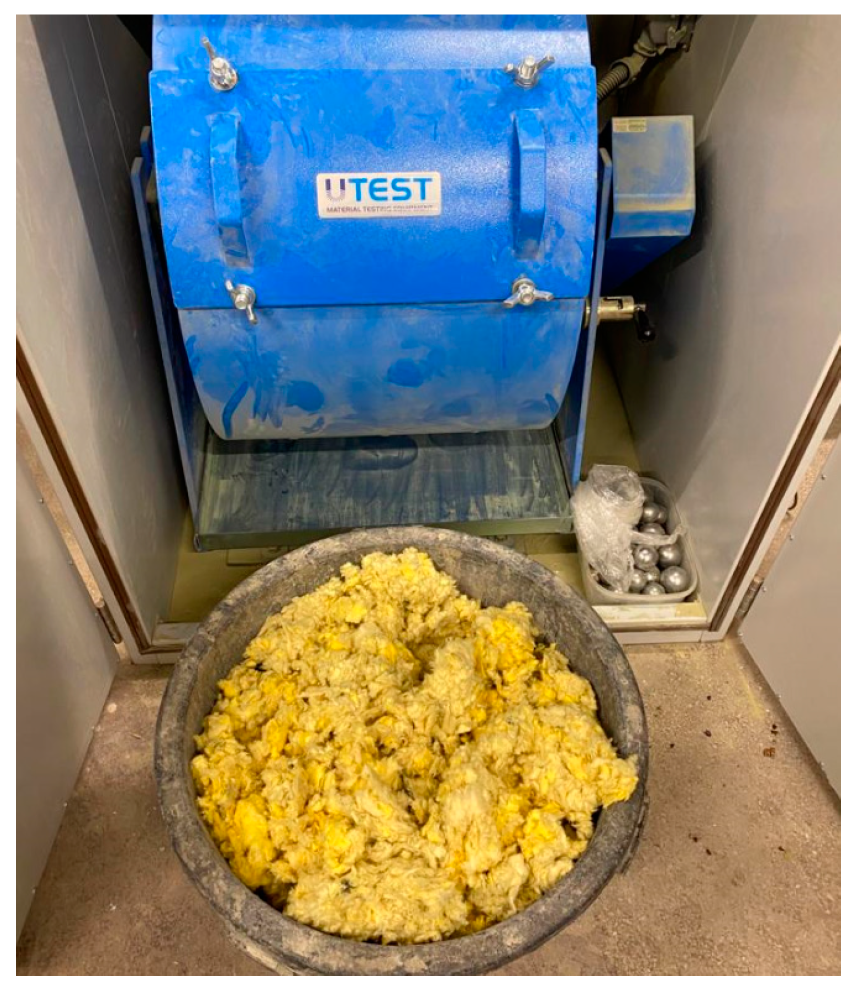

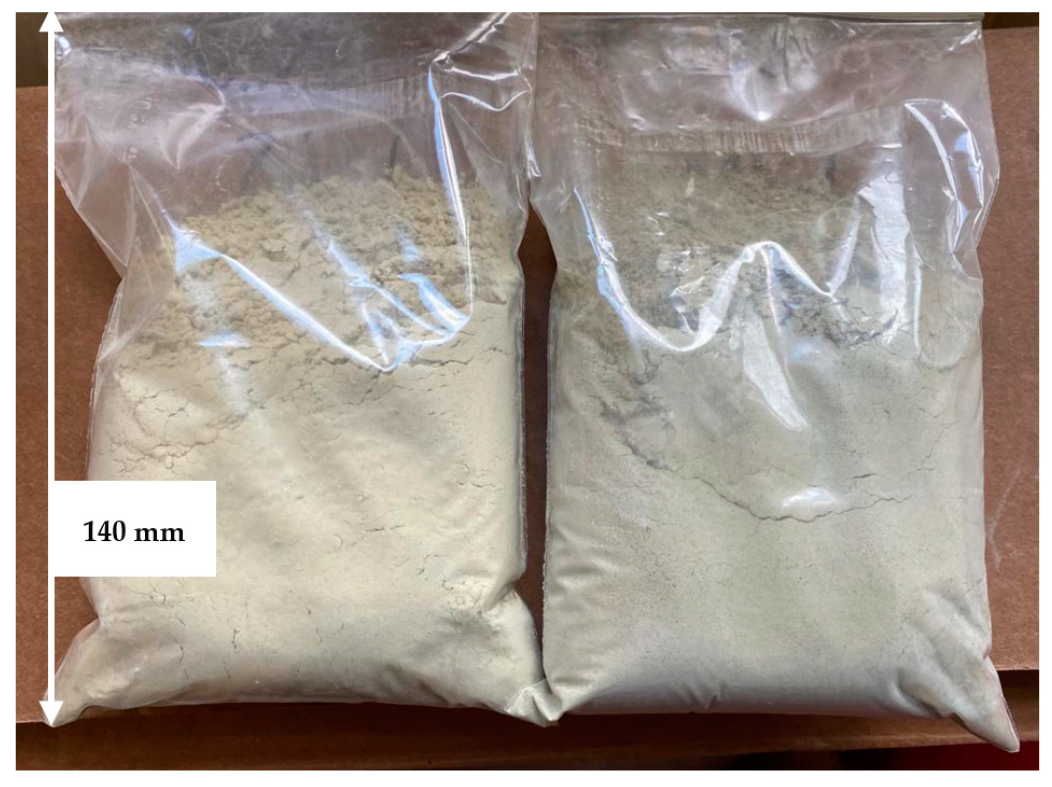
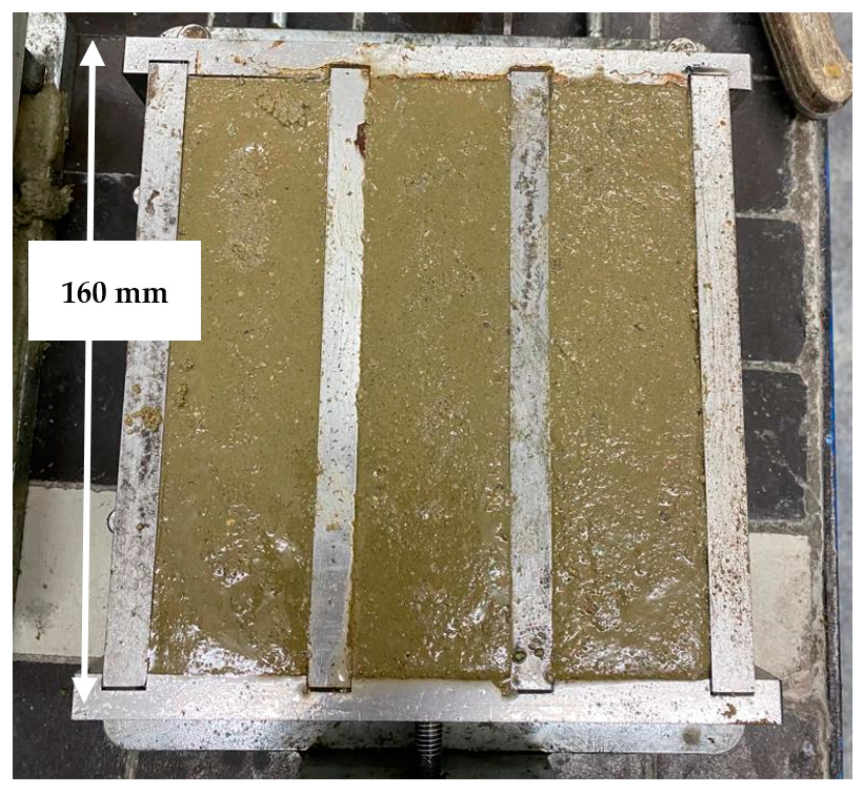
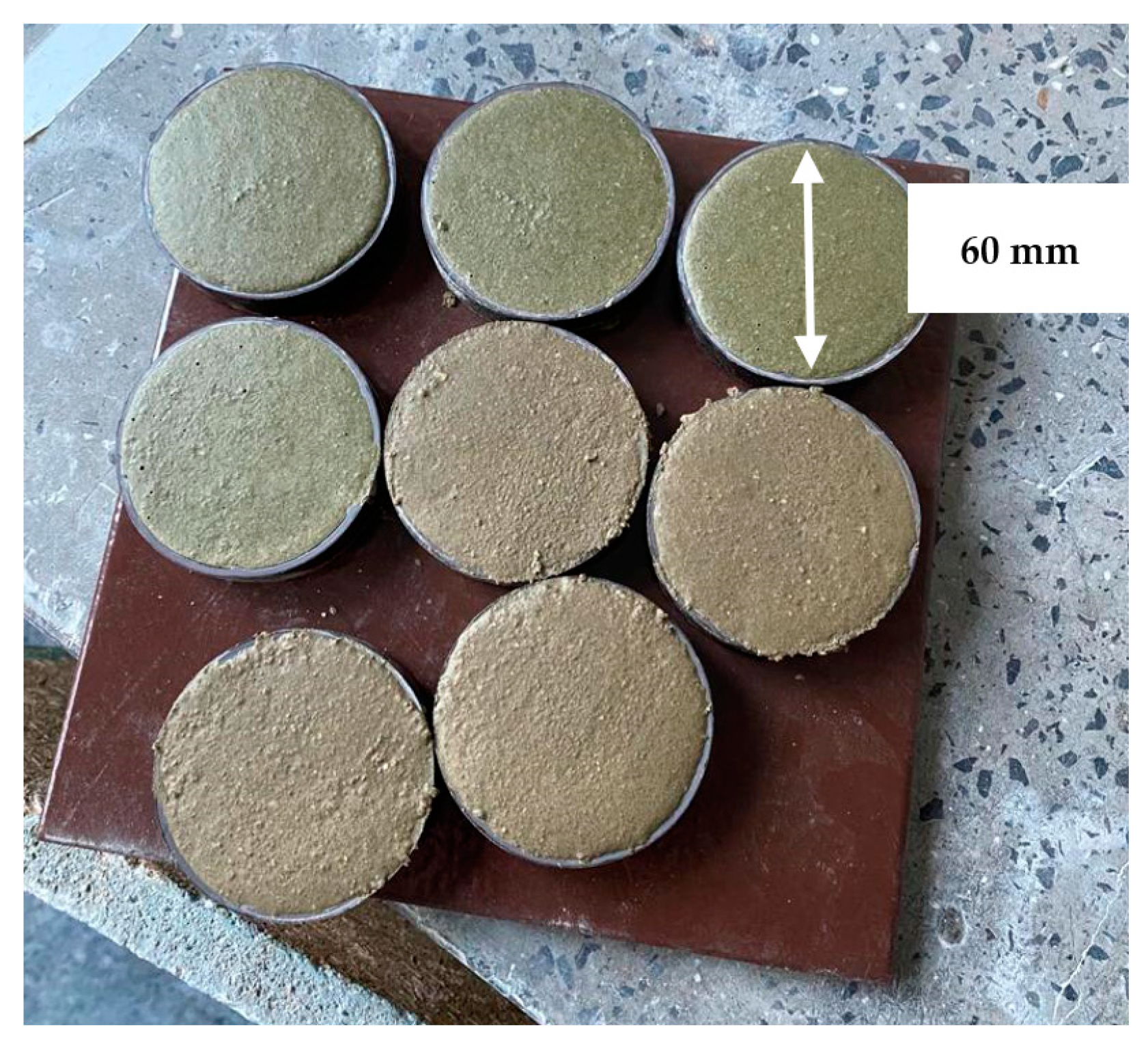

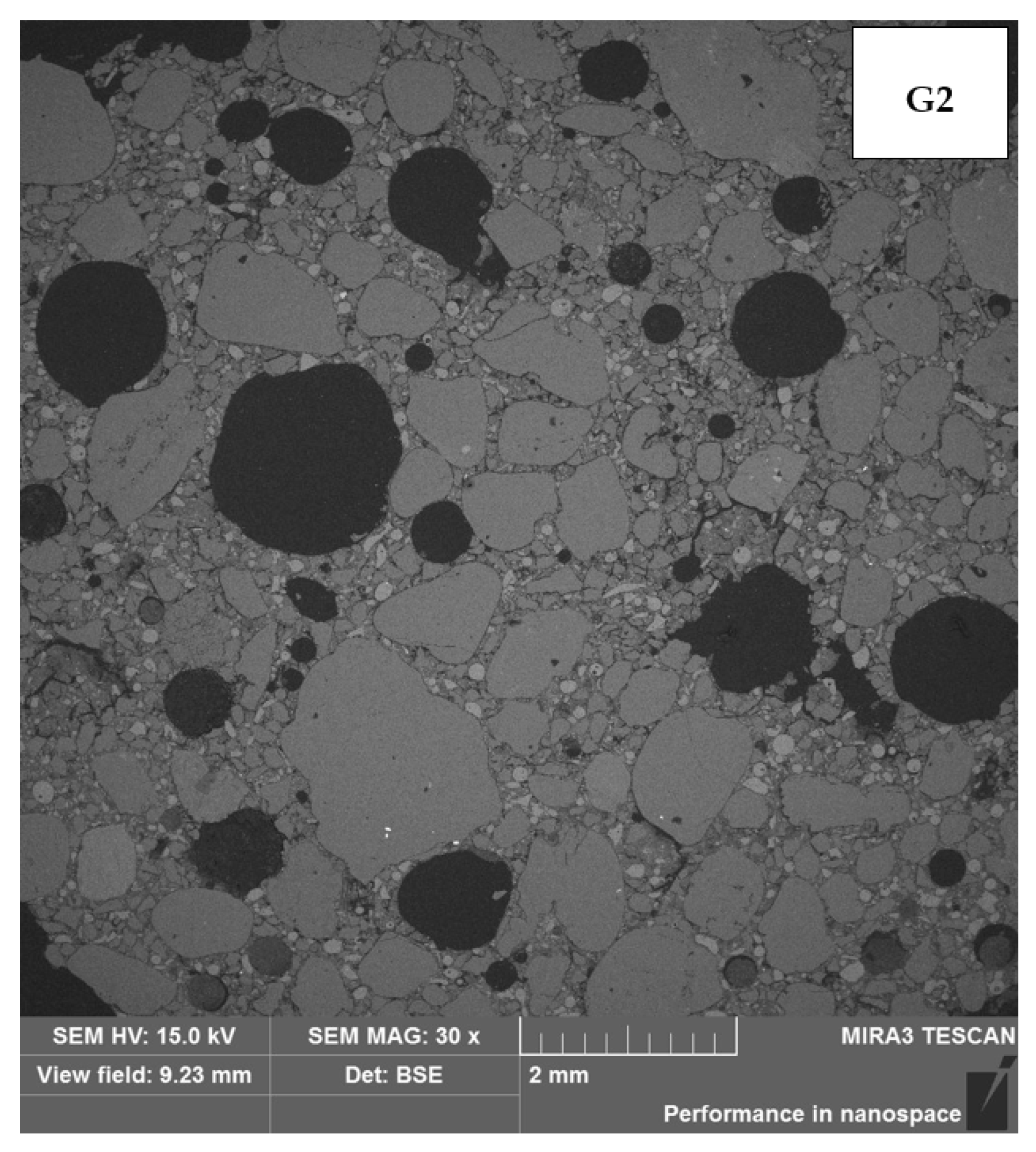
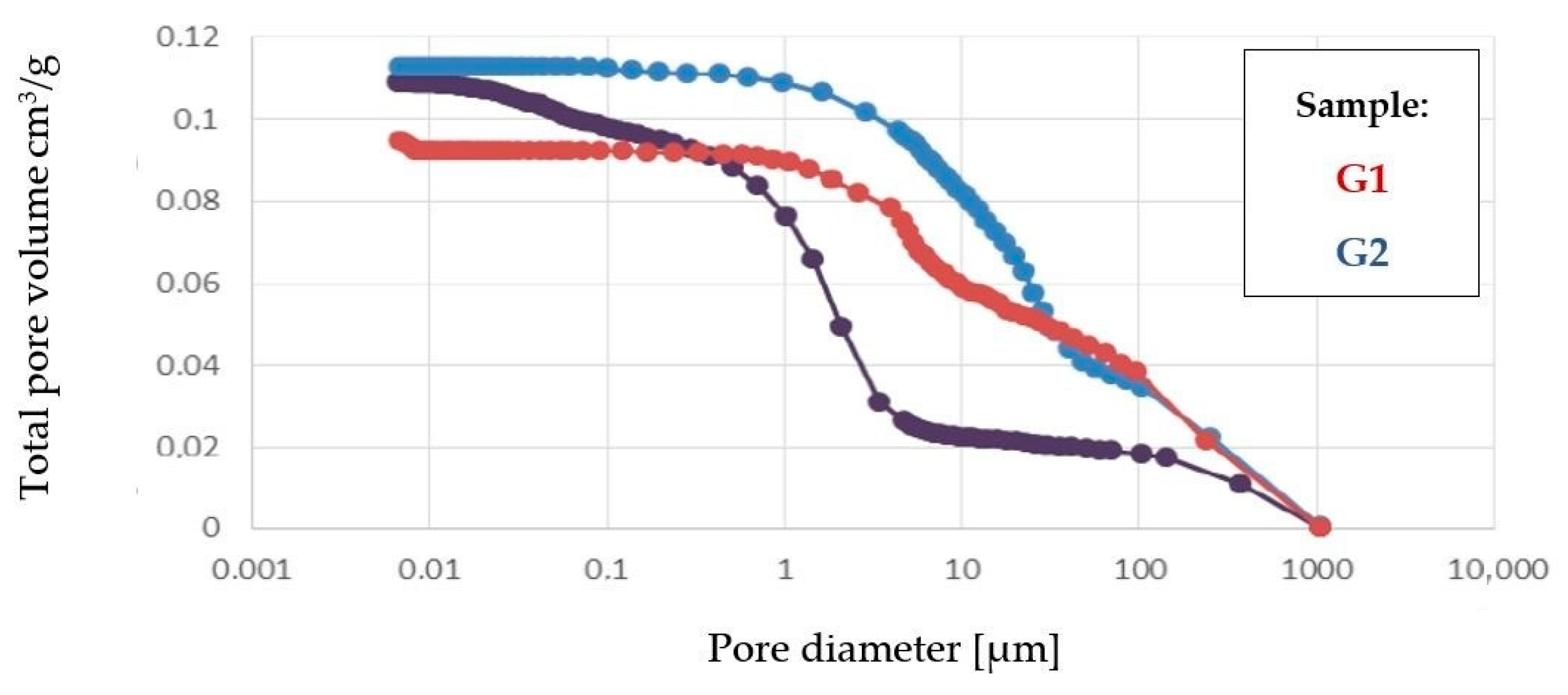

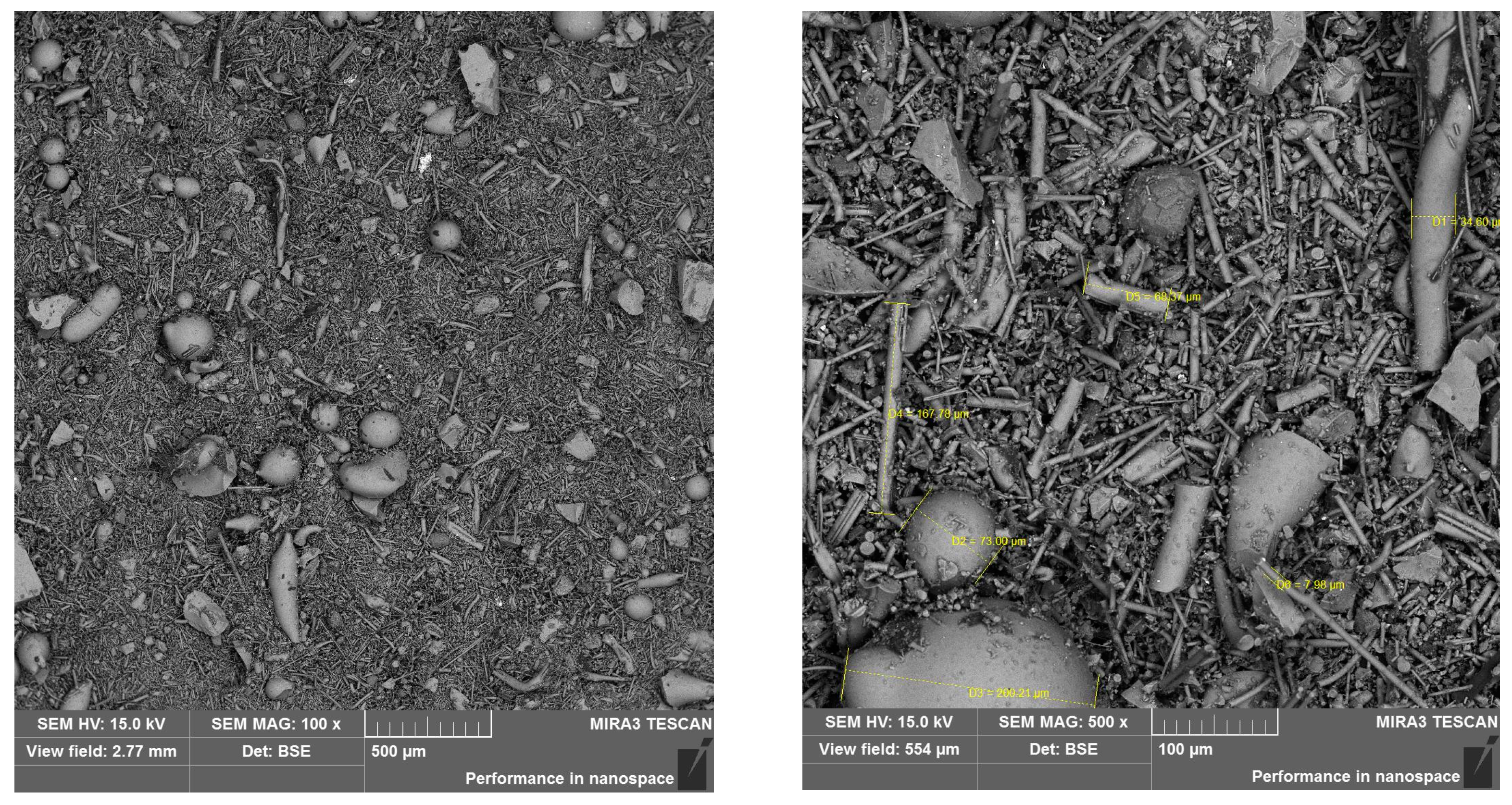
| Sample No. | Mode [μm] | D50 [μm] | D90 [μm] | Specific Surface Area [m2/g] |
|---|---|---|---|---|
| WS2 | 18.080 | 21.991 | 115.515 | 2.36 |
| WM2 | 21.200 | 18.320 | 68.881 | 0.92 |
| O | Na | Mg | Al | Si | Ca | Ti | Cr | Fe | K | |
|---|---|---|---|---|---|---|---|---|---|---|
| WS1 | 42.6 | 13.2 | 1.63 | 1.3 | 34.7 | 5.8 | - | - | - | 0.7 |
| WM1 | 37.5 | 2 | 5.9 | 10 | 20.1 | 16.95 | 0.5 | 1 | 7 | - |
| O | Na | Mg | Al | Si | Ca | Ti | Cr | Fe | K | |
|---|---|---|---|---|---|---|---|---|---|---|
| WS2 | 45.8 | 9.8 | 1.1 | 13.3 | 23.4 | 4.6 | - | - | 0.4 | 0.4 |
| WM2 | 43.4 | 1.6 | 4.1 | 15.8 | 15.8 | 13.9 | 0.3 | 0.7 | 4.2 | 0.1 |
| Sample No. | Actual Density [g/cm3] | Porosity [%] | Open Pore Volume [cm3/g] |
|---|---|---|---|
| G1 | 2.464 | 20.91 | 0.107 |
| G2 | 2.592 | 22.61 | 0.113 |
| Sample No. | Series 1 | Series 2 | Series 3 | ||||||
|---|---|---|---|---|---|---|---|---|---|
| Flexural Strength [MPa] | Compressive Strength [MPa] | Flexural Strength [MPa] | Compressive Strength [MPa] | Flexural Strength [MPa] | Compressive Strength [MPa] | ||||
| G1 | 6.14 | 32.43 | 31.00 | 6.21 | 31.35 | 30.52 | 5.26 | 31.82 | 31.27 |
| G2 | 6.21 | 24.70 | 26.22 | 5.71 | 23.91 | 24.61 | 5.91 | 18.05 | 18.31 |
| Labeled Sample | The Thermal Conductivity Coefficient of a Single Sample, [W/(m·K)] | Average Thermal Conductivity Coefficient(Standard Deviation), [W/(m·K)] |
|---|---|---|
| G1 | 1.052 | 1.053 (0.006) |
| 1.046 | ||
| 1.061 | ||
| G2 | 0.951 | 0.953 (0.006) |
| 0.947 | ||
| 0.962 | ||
| Stone wool | 0.037 [24] | |
| Metakaolin-based geopolymer | 0.966 [38] | |
| Fume-ash-based geopolymer | 0.77 [39] | |
| Foamed geopolymer | 0.092–0.157 [40] 0.079–0.766 [41] 0.030 [42] 0.0947–0.01273 [43] | |
| Ceramic brick | 0.56 [44] | |
| Reinforced concrete | 1.7 [44] | |
Disclaimer/Publisher’s Note: The statements, opinions and data contained in all publications are solely those of the individual author(s) and contributor(s) and not of MDPI and/or the editor(s). MDPI and/or the editor(s) disclaim responsibility for any injury to people or property resulting from any ideas, methods, instructions or products referred to in the content. |
© 2024 by the authors. Licensee MDPI, Basel, Switzerland. This article is an open access article distributed under the terms and conditions of the Creative Commons Attribution (CC BY) license (https://creativecommons.org/licenses/by/4.0/).
Share and Cite
Łaźniewska-Piekarczyk, B.; Smyczek, D. The Effect of Mineral Wool Fiber Additive on Several Mechanical Properties and Thermal Conductivity in Geopolymer Binder. Materials 2024, 17, 483. https://doi.org/10.3390/ma17020483
Łaźniewska-Piekarczyk B, Smyczek D. The Effect of Mineral Wool Fiber Additive on Several Mechanical Properties and Thermal Conductivity in Geopolymer Binder. Materials. 2024; 17(2):483. https://doi.org/10.3390/ma17020483
Chicago/Turabian StyleŁaźniewska-Piekarczyk, Beata, and Dominik Smyczek. 2024. "The Effect of Mineral Wool Fiber Additive on Several Mechanical Properties and Thermal Conductivity in Geopolymer Binder" Materials 17, no. 2: 483. https://doi.org/10.3390/ma17020483






